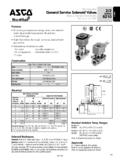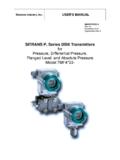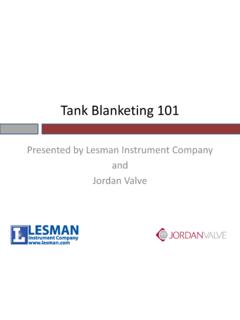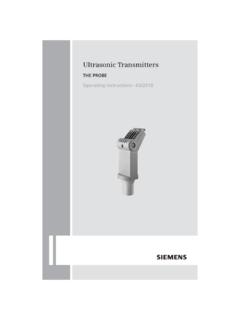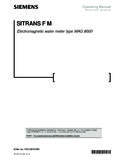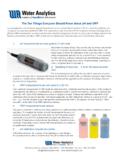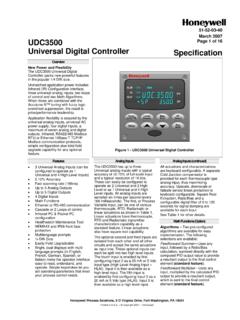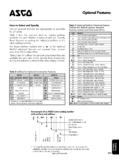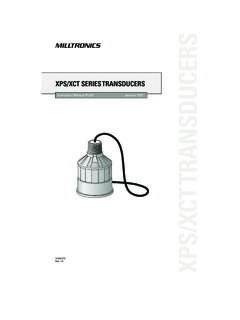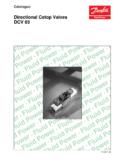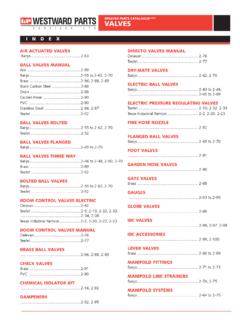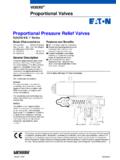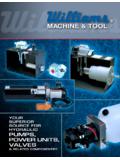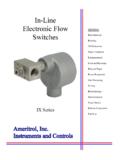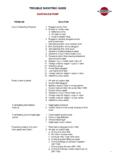Transcription of 4 Engineering Information Solenoid Valves - Lesman
1 4 ENGINEERING447 Figure 1A: Direct Acting, Normally Closed Valve,De-EnergizedFigure 1B: Direct Acting, Normally Closed Valve,EnergizedFigure 2A: Pilot Operated, NormallyClosed Valve, De-EnergizedFigure 2B: Pilot Operated, Normally Closed Valve,EnergizedFigure 3A: Pilot Operated, NormallyClosed Valve, De-EnergizedFigure 3B: Pilot Operated, Normally Closed Valve, EnergizedFigure 4A: No Voltage ReleaseManual Reset Valve, Un-Latched, De-EnergizedFigure 4B: No Voltage ReleaseManual Reset Valve,Latched, EnergizedA Solenoid valve is a combination of two basicfunctional units: A Solenoid (electromagnet) with its core A valve body containing one or more orificesFlow through an orifice is shut off or allowed bythe movement of the core when the Solenoid isenergized or de-energized. ASCO Valves have asolenoid mounted directly on the valve body. Thecore is enclosed in a sealed tube, providing acompact, leaktight Acting Valves (Figures 1A, 1B)When the Solenoid is energized in a direct actingvalve, the core directly opens the orifice of aNormally Closed valve or closes the orifice of aNormally Open valve.
2 When de-energized, aspring returns the valve to its original valve will operate at pressures from 0 psi toits rated force needed to open the valve is proportionalto the orifice size and fluid pressure. As the orificesize increases, so does the force required. To openlarge orifices while keeping Solenoid size small, aPilot Operated construction is Pilot Operated Valves (Figures 2A, 2B)Normally, these Valves have a pilot and bleed orifice which enable them to use line pressure the Solenoid is de-energized, the pilot orificeis closed and full line pressure is applied to the topof the piston or diaphragm through the bleed orifice, providing seating force for tight the Solenoid is energized, the core opensthe pilot orifice, relieving pressure from the top ofthe piston or diaphragm via the outlet side of thevalve. The line pressure then opens the valve bylifting the diaphragm or piston off the main constructions are available for 2-way Valves : Floating diaphragm or piston which requires aminimum pressure drop across the valve to remain in the open position (Figures 2A, 2B).
3 Hung-type diaphragm or piston held openmechanically by the Solenoid core. The valveopens and remains open with zero pressure drop(Figures 3A, 3B).Manual Reset Valves (Figures 4A, 4B)Manual reset Valves must be manually latched intoposition and will return to their original position only when the Solenoid has been energized or de-energized, depending on constructionEngineering InformationSolenoid ValvesPrinciples of OperationSolenoid Valves EngineeringR24 ENGINEERING4481 5A: Three-WayNormally Closed Valve,De-Energized1 5B: Three-WayNormally Closed Valve,Energized2-Way Valves (Figures 1A, 1B, 2A, 2B, 3A, 3B)Two-way Valves have one inlet and one outlet pipe connection. They are used to allow or shut off fluidflow, and are available in either:Normally Closed closed when de-energized andopen when Open open when de-energized andclosed when Valves (Figures 5A, 5B)Three-way Valves have three pipe connections and two orifices (when one is open, the other isclosed, and vice versa).
4 They are commonly usedto alternately apply pressure to and exhaust pres-sure from the diaphragm operator of a controlvalve, single -acting cylinder, or rotary modes of operation are available:Normally Closed when the valve is de-energized,the pressure port is closed and the cylinder port isconnected to the exhaust port. When the valve isenergized, the pressure port is connected to thecylinder port and the exhaust port is Open when the valve is de-energized,the pressure port is connected to the cylinder portand the exhaust port is closed. When the valve isenergized, the pressure port is closed and thecylinder port is connected to the exhaust allows the valve to be connected ineither the Normally Closed or Normally Openposition to select one of two fluids or to divert flowfrom one port to Valves (Figures 6A, 6B)Four-way Valves are generally used to operatedouble-acting cylinders or actuators. They havefour or five pipe connections: one pressure, twocylinder, and one or two exhausts.
5 In Position A,pressure is connected to one cylinder port, theother is connected to exhaust. In Position B,pressure and exhaust are reversed at the 6A: Four-Way Valve, De-EnergizedFigure 6B: Four-Way Valve, of Solenoid ValvesEngineering InformationSolenoid Valves EngineeringR24 ENGINEERING449 MAGNET WIREC lass F: 392 F (200 C) Class H: 392 F (200 C) or 428 F (220 C)UL and CSA LISTED600 VOLT LEADSLEAD WIRE 6 STRAND 18 AWG PE COATEDEPOXY ENCAPSULATIONBOBBINC lass F and HPPSCoil Insulation Systems and Temperature LimitationsRedHat II Solenoid Class F 311 F (155 C) and Class H 356 F (180 C)Final Temperature C ( F)Class F LimitClass H LimitCoil ClassTypicalACWattage RatingM6 MXXM12FT FB HT (356 F) 180160(311 F) 155(284 F) 140(266 F) 130120(212 F) 100(194 F) 9080(140 F) 60(125 F) Rise from Power Temperature Limitations and Thermal Characteristics of ASCO RedHat II Solenoids and CoilsThe typical watt ratings given show the relationshipbetween different classes of coil insulation and the watt ratings to achieve higher temperature Information contained in these tables applies only to Non-Explosionproof, AC constructions.
6 Excess margin for higher fluid or ambient temperatureListed ambientTemperature rise due to power inputNotes: As measured by the Resistance Method. Ambient temperatures are directly additive to coil rise fluid temperature is M-6, 50 Hz wattage values, add 2 watts to the indicated of explosionproof codes and surface temperature limitations, the maximum listed ambients for specific valvesshould not be exceeded. Consult factory concerning explosionproof applications where higher-than-listed ambients are temperatures shown are industrial limits. For UL limits, subtract 27 F (15 C) for Class F coils and 36 F (20 C) for Class H Ambient CapabilitiesSolenoid Coils (Non-Electronic*)Except where noted, all ASCO Valves areequipped with coils which can be energized con-tinuously without danger of overheating or coils have 18" leads which can be con-nected to any controlling device. Spade, screwterminal, and DIN-type spade connector coils arealso available.
7 For three phase power systems, thetwo leads can be connected to any two of thethree coils are constructed in accordance withUnderwriters Laboratories Inc., NEMA, IEEE, andother industrial standards ASCO Class B, F, andH insulation systems are UL listed in theRecognized Component Index (yellow book)under Guide No. AC ambient capabilities, see chart to the ambient capabilities are 104 F (40 C), or 131 F(55 C) for RedHat II depending on ambients are based on a minimum availablevoltage of 85% of nominal. If minimum availablevoltage is greater, a higher ambient limitation maybe possible. Consult factory for InformationSolenoid Valves * See Pages 469-472 for RedHat Next GenerationElectronic coils. EngineeringR24 ENGINEERING450 Coil Operating Voltage Ranges All coils are designed for industrial operating voltagesand can be used on the following voltage ranges:Note:Special coils are required for battery chargingcircuits where wider voltage ranges are typicallyencountered.
8 For these applications, special continuous duty Class H coils are available that willaccom modate a voltage range equivalent to 12%over nominal, 28% under nominal, and a 140 F(60 C) ambient. Standard nominal voltages are125 and 250 DC, which translate to a voltagerange of 90-140 and 180-280, respectively. Addprefix HC to the catalog number. HC prefix isonly applicable to Valves with coil classes FT andHT. Consult factory for other ASCO Valves , depending upon construction,will operate at 15% under nominal voltage andmaximum operating pressure differential, and arecapable of operating for short periods at 10% overnominal voltage. For coil classes other than FT andHT, over voltage is not recommended. For widervoltage ranges than shown here or for operating voltage ranges for specific catalog numbers,please consult your local ASCO sales ConsumptionPower consumption can be determined from theratings shown on individual Series pages.
9 For ACvalves, the watts, volt-ampere inrush (the highmomentary surge occurring at coil energization),and volt-ampere holding (the continuous drawfollowing inrush) are current rating for inrush and holding may bedetermined by dividing the voltage into the volt-amp rating:Notes:1. When a valve has been energized for a longperiod, the Solenoid becomes hot and can betouched by hand for only an instant. This is a perfectly safe operating temperature. Any excessiveheating will be indicated by smoke and the odorof burning coil Valves for AC service can be converted toother AC voltages simply by changing the , DC Valves can be converted to otherDC converting from AC to DC, orvice versa, consult your local ASCO sales officefor ConstructionsInternal parts in contact with fluids are of non-magnetic 300 and magnetic 400 series stainlesssteel. In AC constructions, the shading coil is normally copper, except that silver is mostly used invalves with stainless steel bodies.
10 Other materialsare available, when required. In DC constructions, no shading coil is required. Typically, the coretubes are of 300 series stainless Valves have no inrush current. The amp ratingcan be determined by dividing the voltage intothe DC watt rating: Engineering InformationSolenoid ValvesACDCN ominalVoltage RatingNormal Operating RangeNominalVoltage RatingNormal Operating 2420-25240204-240120102-126480408-480240 204-252 InrushAmpsvolt-amp inrushvoltage=HoldingAmpsvolt-amp holdingvoltage=Ampswatts (DC)voltage= EngineeringR24 ENGINEERING451 Solenoid EnclosuresASCO offers two types of enclosures, each for avariety of applications: a one-piece moldedepoxy construc tion called the RedHat II solenoidand a conventional RedHat metallic meet ICS-6 ANSI/NEMA, and UL Standards429, 508, and/or 1002. These standards defineenclosure protection levels and the tests passedto earn each Type designation. (See Page 469 forRedHat Next Generation Solenoid Enclosures).

